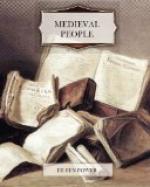CHAPTER VI
Thomas Betson
A MERCHANT OF THE STAPLE IN THE FIFTEENTH CENTURY
Some men of noble stock
were made, some glory in the murder blade:
Some praise a Science
or an Art, but I like honourable Trade!
—JAMES ELROY FLECKER
The Golden Journey to Samarcand
The visitor to the House of Lords, looking respectfully upon that august assembly, cannot fail to be struck by a stout and ungainly object facing the throne—an ungainly object upon which in full session of Parliament, he will observe seated the Lord Chancellor of England. The object is a woolsack, and it is stuffed as full of pure history as the office of Lord Chancellor itself. For it reminds a cotton-spinning, iron-working generation that the greatness of England was built up, not upon the flimsy plant which comes to her to be manufactured from the Far East and West of the world, nor upon the harsh metal delved from her bowels, but upon the wool which generation after generation has grown on the backs of her black-faced sheep. First in the form of a raw material sought after eagerly by all the cloth-makers of Europe, then in the form of a manufacture carried on in her own towns and villages, and sent out far and wide in ships, wool was the foundation of England’s greatness right up to the time of the Industrial Revolution, when cotton and iron took its place. So if you look at old pictures of the House of Lords, in Henry VIII’s reign, or in Elizabeth’s, you will see the woolsack before the throne,[1] as you will see it if you visit the House today. The Lord Chancellor of England is seated upon a woolsack because it was upon a woolsack that this fair land rose to prosperity.
The most remarkable body of traders in England during the Middle Ages were the Merchants of the Staple, who traded in wool. The wool trade had for long been the largest and most lucrative body of trade in the country, and it was one in which the Kings of England were particularly interested, for their customs revenue was drawn largely from wool and wool fells; and, moreover, when they desired to borrow money in anticipation of revenue it was to the wool merchants that they turned, because the wool merchants were




